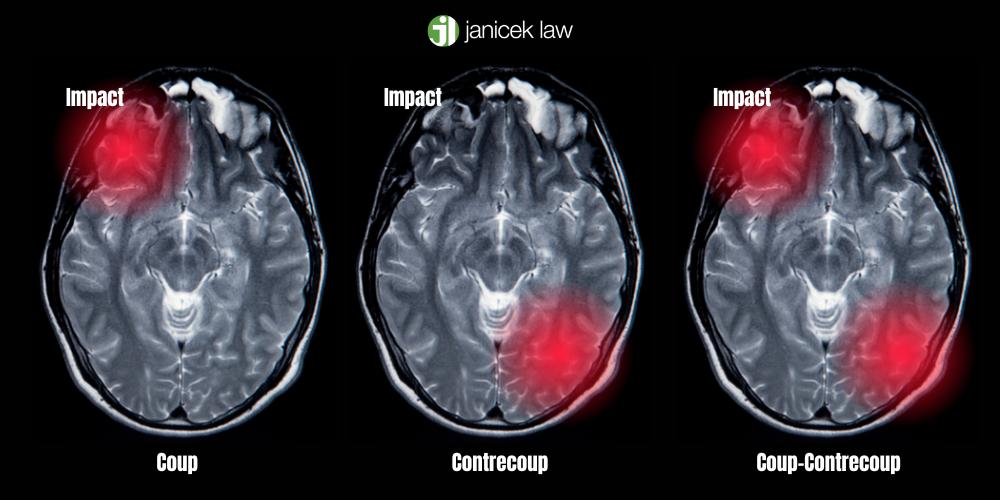Did you know: Americans suffer from approximately 2.8 million traumatic brain injuries (TBI) every year, with about a third of those injuries occurring in children. One of the many common types of traumatic brain injuries that Americans suffer from are coup-contrecoup injuries. A coup-contrecoup injury occurs when the head suffers a violent impact, and then the brain hits the skull at a high rate of speed. Without immediate medical attention, victims of a coup-contrecoup brain injury can suffer severe damage to the brain as well as long-term disability. Below, our San Antonio personal injury lawyers break down the details of this type of head trauma, and explain how you can potentially recover financial compensation for your suffering.
If you have suffered any kind of traumatic injury due to a car accident, a slip and fall accident, or even a medical malpractice incident, you may have grounds to file a civil lawsuit in the state of Texas. Call Janicek Law at 210-366-4949 to schedule a free consultation today.
Coup vs. Contrecoup vs. Coup-Contrecoup Brain Injuries
Coup, contrecoup, and coup-contrecoup brain injuries are all types of cerebral contusions that commonly occur in the frontal lobe and/or the temporal lobe. A contusion is basically a bruise; it occurs when blood pools at the site of impact or injury. So coup and contrecoup injuries occur when there’s bleeding under the surface of the brain. The main difference between these brain injuries is where the bleeding occurs in reference to the impact.

Coup Brain Injury
A coup injury occurs at the location of the impact, usually as a result of a moving object hitting a stationary head. For example: flying footballs or baseballs can cause coup injuries. This blunt impact injury of the head can range from mild to severe. Along with bruising, the brain can also swell and even hemorrhage depending on the severity of the accident.
Contrecoup Brain Injury
A contrecoup brain injury occurs when the brain suffers a contusion on the opposite side of the initial impact. This type of brain injury is often caused by a moving head hitting a stationary object, such as a steering wheel. When the head collides with a stationary object at a high rate of speed, the brain strikes the inside of the skull on the opposite side of the collision. This is what causes the bruising, swelling, and possible hemorrhaging.
Medical professionals refer to coup and contrecoup as focal brain injuries because they occur in very specific spots on the brain – usually right at the impact or on the opposite side of the impact. A focal brain injury is the opposite of a diffuse axonal injury, which occurs when the brain rotates inside the skull and then suffers widespread damage in multiple locations.
Coup-Contrecoup Brain Injury
Finally, a coup-contrecoup brain injury occurs when the brain bleeds in two locations: at the site of the impact and on the opposite side of the impact. A coup-contrecoup injury affects those who hit their head on a stationary object, causing their brain to “bounce back” and hit the inside of the skull on the opposite side. This is very common in car accidents.
Most coup-contrecoup injuries are misdiagnosed at first because the doctor may only pay attention to the part of the head that sustained the initial impact. In cases like this, many coup-contrecoup victims can suffer permanent brain damage from lack of medical attention for both contusions.
What’s the Difference Between a Concussion and a Coup-Contrecoup Brain Injury?
Concussions and coup-contrecoup injuries are both common types of traumatic brain injuries (TBIs) that result from some kind of blow to the head. But how do they differ?
Firstly, concussions are considered mild TBIs while cerebral contusions (such as coup-contrecoup injuries) are considered more severe, as far as TBIs go. Concussions also don’t have to involve brain bleeding, but sometimes they do depending on the severity of the accident. Additionally, concussions are often characterized by widespread damage across the brain, whereas coup-contrecoup injuries are localized injuries.
Lastly, while concussions and cerebral contusions often share similar symptoms, some symptoms are mostly associated with concussions. For example, concussions produce lots of deficits in psychological and cognitive function, such as memory loss and mood swings.
Symptoms of a Coup-Contrecoup Brain Injury
Symptoms from a coup-contrecoup injury will typically depend on what part of the brain sustains damage. For example, frontal lobe damage will present different symptoms than temporal lobe damage.
If you suffer a coup and contrecoup injury, you may experience the following symptoms:
- A visible, cut, bruise, or lump on the outside of the head at the site of impact
- High blood pressure
- Dilated pupils
- Slow heart rate
- Changes in breathing
- Increased cranial pressure (from brain swelling and bleeding)
- Loss of consciousness
- Intense headache
- Changes in vision
- Dizziness
- Nausea and/or vomiting
- Poor concentration and attention
- Ringing in the ears
- Difficulty speaking and understanding language
- Light and sound sensitivity
- Poor motor control
- Difficulty performing executive functions (problem solving, decision making, or multi-tasking)
- Seizures (in severe cases)
Head injury victims who don’t seek medical attention are at risk of suffering brain death or long-term physical complications such as frequent seizures, severe headaches, memory loss, communication difficulties, and so much more.
Common Causes of Coup-Contrecoup Brain Injuries
In most cases, coup-contrecoup injuries occur from the following accidents:
- Motor vehicle accidents such as car accidents, 18 wheeler accidents, motorcycle accidents, boat accidents, bicycle accidents, and even pedestrian accidents
- Slip and fall accidents
- Medical malpractice and birth injuries
- Shaking a baby
- Sports accidents
- Violent attacks
- Explosive blasts
- Any other types of blunt force trauma to the head

Treatment for Coup-Contrecoup Brain Injuries
After a doctor diagnoses a coup-contrecoup brain injury (usually through magnetic resonance imaging), they will create an individualized treatment plan depending on the severity of the injury and the symptoms. A very minor coup-contrecoup injury can heal with minimal medical intervention, such as rest, ice therapy, and pain medications.
The biggest risk from this type of traumatic brain injury is increased intracranial pressure. So along with managing TBI symptoms, doctors will consistently monitor intracranial pressure. If intracranial pressure becomes too high, doctors may resort to several treatments, such as diuresis, head elevation, sedation, and hypertonic saline. In the most severe cases of coup-contrecoup injuries, surgical intervention may be necessary.
Depending on the severity of the coup-contrecoup injury and how quickly the victim was able to receive medical attention, the victim may experience long-term disability in some way. Physical and cognitive deficits may require numerous sessions of physical therapy in order to improve quality of life.
Can You Sue for a Traumatic Brain Injury?
Yes, you can sue for any type of traumatic brain injury – including a coup-contrecoup brain injury – that was caused by someone else’s negligence. For example, if you suffered a coup-contrecoup injury as a result of a car accident, slip and fall accident, or medical malpractice incident that wasn’t your fault, you may have grounds to file a civil lawsuit to recover damages.
In order to build the strongest possible personal injury case, you must prove that negligence occurred. You can do this by gathering evidence to prove the four elements of negligence.
- Duty of Care refers to the level of care that everyone should have in their jobs or daily activities in order to promote the safety of self and others. For example, all drivers owe each other a duty of care to drive safely, carefully, and soberly in order to prevent a car accident.
- Breached Duty of Care means that the at-fault party failed to take proper care in a certain situation.
- Causation: The breached duty of care directly caused the victim’s coup-contrecoup injury.
- Damages: The victim suffered a variety of damages from their traumatic brain injury. Therefore, they should receive full compensation from the at-fault party.
Each personal injury lawyer at Janicek Law has extensive experience in representing and defending victims of traumatic brain injuries. We can help you gather sufficient evidence to prove these elements of negligence so that you may recover a fair settlement from the at-fault party. Types of evidence that may help prove that negligence occurred include medical records, witness statements, police reports, surveillance camera footage, pictures and videos of the accident scene, and more.
Traumatic Brain Injury Damages
A San Antonio personal injury lawyer at Janicek Law can help TBI victims recover compensation for the following types of damages:
- All medical bills
- All physical therapy bills
- Caretaking expenses
- Expenses associated with necessary medical equipment
- Lost wages
- Loss of earning capacity if the TBI results in long-term disability which prevents a victim from completing their normal job duties
- Physical pain and suffering
- Mental anguish and/or emotional distress
- Mental health counseling bills
- Permanent disability
- Loss of consortium
- Loss of quality of life
- Funeral and burial expenses if the brain damage results in wrongful death

Call San Antonio Personal Injury Lawyers at Janicek Law
If you have suffered any kind of severe injury, such as a head injury, due to someone else’s negligence, you may have grounds to sue for a variety of damages. Diagnosing and treating coup-contrecoup brain injuries can be incredibly expensive, and not only that, but this type of head trauma can drastically change your life for years to come. You deserve to receive full compensation for these damages, and a San Antonio personal injury lawyer can help you do just that. Call Janicek Law at 210-366-4949 to schedule a free consultation today.

